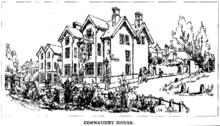Industrial school

In England, the 1857 Industrial Schools Act was intended to solve problems of juvenile vagrancy, by removing poor and neglected children from their home environment to a boarding school. The Act allowed magistrates to send disorderly children to a residential industrial school. An 1876 Act led to non-residential day schools of a similar kind.
There were similar arrangements in Scotland, where the Industrial Schools Act came into force in 1866. The schools cared for neglected children and taught them a trade,[1] with an emphasis on preventing crime. Glasgow Industrial School for Girls is an example formed in 1882.
They were distinct from reformatories set up under the 1854 Youthful Offenders Act (the Reformatory Schools Act) which included an element of punishment. Both agreed in 1927 to call themselves approved schools.
In Ireland, the Industrial Schools Act of 1868 established industrial schools (Irish: scoileanna saothair) to care for "neglected, orphaned and abandoned children". By 1884 there were 5,049 children in such institutions.[2]
Context
An Industrial Feeding School was opened in Aberdeen in 1846. Industrial Schools like the co-temporous Ragged schools were set up by volunteers to help destitute children but they believed that an education was not enough, these children needed to be removed from the harmful environment of the street, and trained to be industrious and given a trade they could practise. [3]
Some schools were residential but other children were 'day-boys'. The regime was severe, with a tightly timetabled daily routine that stretched from waking at 6.00am going to bed at 7.00pm. During the day there were set times for religion and moral guidance, formal schooling, doing housework, eating, learning trades, with three invervals for play. The boys trades were gardening, tailoring and shoemaking; the girls learned housework and washing, knitting, and sewing.[3]
Industrial Schools Act 1857
The Industrial Schools Act 1857 gave magistrates the power to sentence homeless children between the ages of 7 and 14 years, who were brought before the courts for vagrancy to a spell in an industrial school.
In 1861 a further act strengthened the powers of the magistrate "to include:
- Any child apparently under the age of fourteen found begging or receiving alms (money or goods given as charity to the poor).
- Any child apparently under the age of fourteen found wandering and not having any home or visible means of support, or in company of reputed thieves.
- Any child apparently under the age of twelve who, having committed an offence punishable by imprisonment or less.
- Any child under the age of fourteen whose parents declare him to be beyond their control".[3]
It was not until 1875 that it became compulsory to register births and vagrants genuinely didn't know their age. Also children would say any age that was convenient to them at the time.[3]
Homeless children who had not committed any more serious crime were sent to industrial schools, while children who had been arrested for other crimes were sent to juvenile prisons known as reformatories.
Financial accountability
The intention was that the cost of attending such a school would be met by the parents, which was an interesting concept for a child who was sent there because he was already homeless. The state had to provide. The system expanded rapidly, and magistrates preferred to send miscreants to a school rather than a reformatory. There was public unrest about the mounting cost.[3] From 1870, responsibility for the Industrial schools passed to the local Committee of Education.
Best estimates suggest that, at the peak, there were 224 certified industrial schools in England and 50 in Scotland. There were others operating without certification or when certification had been removed. Name changing was common. Directly after World War I, one hundred closed and in 1933 there were only 55. They agreed to change their names to approved schools in 1927 and the Approved Schools Act of 1933 merged them to form a single system.[1]
See also
References
- 1 2 Gillian Carol Gear (1999). "Industrial Schools in England, 1857-1933" (PDF). University of London Institute of Education. Retrieved 9 April 2016.
- ↑ "INDUSTRIAL SCHOOLS (IRELAND). HC Deb". Hansard. UK Parliament (vol 285 cc1022-4). 10 March 1884.
- 1 2 3 4 5 "Hidden Lives Revealed: A Virtual Archive - Children in Care 1881-1981". www.hiddenlives.org.uk. Retrieved 27 March 2017.
Bibliography
- Report of the Commission to Inquire into Child Abuse, 2009.Report, IE: Child abuse commission.
- Vaccine trials (report), IE: Child abuse commission, 2003-06-05. Vaccine Trials
External links
- The Industrial School system in the United Kingdom
- Industrial Schools in Scotland
- Industrial Schools in England